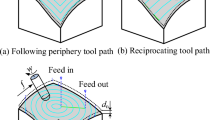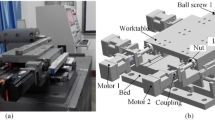Abstract
There are large volume of existing literatures focused on cutting force modeling, but so far only few research has been reported on cutting loads decomposition model to calculate cutting loads components acted on five axes of the machine, which, however, directly affect five-axis tracking accuracy. To this end, a generalized cutting loads decomposition model of five-axis serial machine tools is proposed, which provides a mathematical basis to evaluate the cutting loads components. A cutting loads decomposition model is first developed based on kinematics and virtual work analysis, then a generalized cutting loads decomposition model is established by differentiating the forward kinematics model based on the screw theory. Kinematic factors that affect the cutting load components on translational and rotary axes are also analyzed, which provides a guidance to optimize the workpiece setup location to reduce the cutting loads components acted on rotary axes. Experiments and simulations on a table-tilting five-axis machine tool verify the effectiveness of the proposed model.
Similar content being viewed by others
Abbreviations
- \(\boldsymbol {F}=\left [F_{x}, F_{y}, F_{z}, n_{x}, n_{y}, n_{z} \right ]^{\text {T}}\) :
-
Cutting loads acted on the workpiece
- \(\boldsymbol {\tau }=\left [f_{x}, f_{y}, f_{z}, \tau _{p}, \tau _{s} \right ]^{\text {T}}\) :
-
Cutting loads components acted on five axes
- \(\boldsymbol {P}=\left [P_{x},P_{y},P_{z} \right ]^{\text {T}}\) :
-
Tool tip position
- \(\boldsymbol {O}=\left [O_{i},O_{j},O_{k} \right ]^{\text {T}}\) :
-
Tool orientation
- \(\boldsymbol {q}=\left [x,y,z,\theta _{p},\theta _{s} \right ]^{\text {T}}\) :
-
Axis displacements in machine coordinates
- J :
-
Tool pose Jacobian matrix
- \(\left [g_{wt}\right ]\) :
-
Forward kinematics transfer matrix
- \(\left [g_{bw}\right ],~\left [g_{bt}\right ]\) :
-
Transfer matrix of the workpiece and tool frame relative to the foundation frame
- r p t , r o t :
-
Cutter position and orientation vectors relative to the tool frame
- \(\left (\boldsymbol {\xi }_{x},~\boldsymbol {\xi }_{y},~\boldsymbol {\xi }_{z} \right ),\left (\boldsymbol {\xi }_{p},~\boldsymbol {\xi }_{s}\right )\) :
-
Twist coordinates of translational and rotary axes
- \(\left (\boldsymbol {v}_{x},\boldsymbol {v}_{y},\boldsymbol {v}_{z}\right ),~\left (\boldsymbol {\omega }_{p},\boldsymbol {\omega }_{s}\right )\) :
-
Unit vectors of translational and rotary axes
References
Wan M, Kilic ZM, Altintas Y (2015) Mechanics and dynamics of multifunctional tools. J Manuf Sci Eng 137(1):011019
Wan M, Ma Y, Zhang W, Yang Y (2015) Study on the construction mechanism of stability lobes in milling process with multiple modes. Int J Adv Manuf Technol 79(1–4):589–603
Fussell BK, Jerard RB, Hemmett JG (2003) Modeling of cutting geometry and forces for 5-axis sculptured surface machining. Comput Aided Des 35(4):333–346
Lazoglu I, Boz Y, Erdim H (2011) Five-axis milling mechanics for complex free form surfaces. CIRP Ann Manuf Technol 60(1):117–120
Ozturk E, Tunc LT, Budak E (2009) Investigation of lead and tilt angle effects in 5-axis ball-end milling processes. Int J Mach Tools Manuf 49(14):1053–1062
Sun Y, Guo Q (2011) Numerical simulation and prediction of cutting forces in five-axis milling processes with cutter run-out. Int J Mach Tools Manuf 51(10–11):806–815
Yang Y, Zhang W, Wan M, Ma Y (2013) A solid trimming method to extract cutter–workpiece engagement maps for multi-axis milling. Int J Adv Manuf Technol 68(9):2801–2813
Tuysuz O, Altintas Y, Feng H (2013) Prediction of cutting forces in three and five-axis ball-end milling with tool indentation effect. Int J Mach Tools Manuf 66:66–81
Huang T, Zhang X, Ding H (2013) Decoupled chip thickness calculation model for cutting force prediction in five-axis ball-end milling. Int J Adv Manuf Technol 69(5):1203–1217
Wan M, Pan W, Zhang W, Ma Y, Yang Y (2014) A unified instantaneous cutting force model for flat end mills with variable geometries. J Mater Process Technol 214(3):641–650
Wan M, Ma Y, Feng J, Zhang W (2016) Study of static and dynamic ploughing mechanisms by establishing generalized model with static milling forces. Int J Mech Sci 114:120–131
Altintas Y, Erkorkmaz K, Zhu WH (2000) Sliding mode controller design for high speed feed drives. CIRP Ann Manuf Technol 49(1):265–270
Altintas Y (2012) Manufacturing automation: metal cutting mechanics, machine tool vibrations, and CNC design, 2nd edn. Cambridge University Press, New York
Tsutsumi M, Saito A (2004) Identification of angular and positional deviations inherent to 5-axis machining centers with a tilting-rotary table by simultaneous four-axis control movements. Int J Mach Tools Manuf 44 (12–13):1333–1342
Moriwaki T (2008) Multi-functional machine tool. CIRP Ann Manuf Technol 57(2):736–749
Sorby K (2007) Inverse kinematics of five-axis machines near singular configurations. Int J Mach Tools Manuf 47(2):299–306
Lamikiz A, Lacalle L, Ocerin O, Diez D, Maidagan E (2008) The Denavit and Hartenberg approach applied to evaluate the consequences in the tool tip position of geometrical errors in five-axis milling centres. Int J Adv Manuf Technol 37(1–2):122–139
Boz Y, Lazoglu I (2013) A postprocessor for table-tilting type five-axis machine tool based on generalized kinematics with variable feedrate implementation. Int J Adv Manuf Technol 66(9–12):1285–1293
Moon S, Moon Y, Kota S, Landers RG (2001) Screw theory based metrology for design and error compensation of machine tools. In: Proceedings of ASME 2001 design engineering technical conferences(DETC2001). Pittsburgh
Fu G, Fu J, Xu Y, Chen Z (2014) Product of exponential model for geometric error integration of multi-axis machine tools. Int J Adv Manuf Technol 71(9–12):1653–1667
Huang T, Liu HT, Chetwynd DG (2011) Generalized Jacobian analysis of lower mobility manipulators. Mech Mach Theory 46(6):831–844
Tian W, Gao W, Zhang D, Huang T (2014) A general approach for error modeling of machine tools. Int J Mach Tools Manuf 79:17–23
Yang J, Altintas Y (2013) Generalized kinematics of five-axis serial machines with non-singular tool path generation. Int J Mach Tools Manuf 75:119–132
Yang J, Altintas Y (2015) A generalized on-line estimation and control of five-axis contouring errors of CNC machine tools. Int J Mach Tools Manuf 88:9–23
Yang J, Mayer JRR, Altintas Y (2015) A position independent geometric errors identification and correction method for five-axis serial machines based on screw theory. Int J Mach Tools Manuf 95:52–66
Spong MW, Hutchinson S, Vidyasagar M (2006) Robot modeling and control. Wiley, New York
Murray RM, Li Z, Sastry SS (1994) A mathematical introduction to robotic manipulation. CRC Press, Florida
Yang J, Ding H (2016) A new position independent geometric errors identification model of five-axis serial machine tools based on differential motion matrices. Int J Mach Tools Manuf 104:68–77
Author information
Authors and Affiliations
Corresponding author
Rights and permissions
About this article
Cite this article
Yang, J., Huang, T., Yang, M. et al. Generalized cutting loads decomposition model of five-axis serial machine tools based on the screw theory. Int J Adv Manuf Technol 91, 399–410 (2017). https://doi.org/10.1007/s00170-016-9745-3
Received:
Accepted:
Published:
Issue Date:
DOI: https://doi.org/10.1007/s00170-016-9745-3




